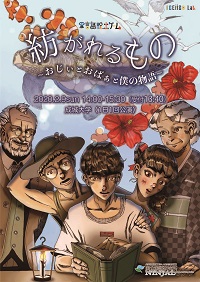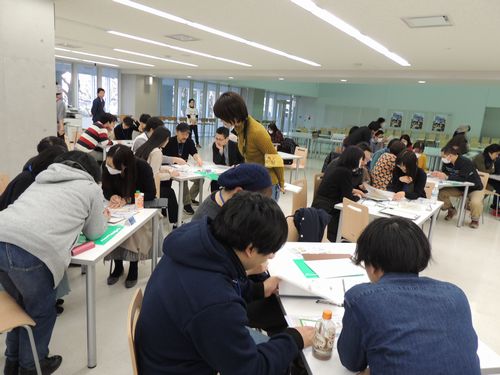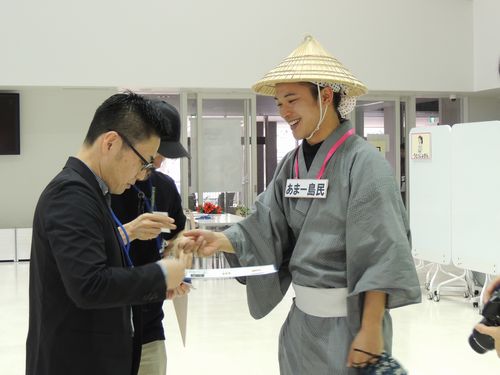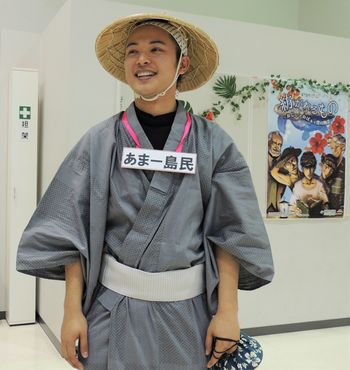Interview with liberal arts communicator: Yuto Niinaga

The National Institutes for the Humanities (NIHU) has been conducting research on human cultures from diverse angles to understand how individuals as well as nature and humans can harmoniously coexist with each other. To that end, we believe it is critical to facilitate communications between the researchers at the forefront of research and society.
As part of this effort to enhance such communications, NIHU holds various events for the general public and also provides training programs for liberal arts communicators who facilitate and engage in “two-way communication” between experts and non-experts. Who are these “liberal arts communicators?” What kinds of activities do they do? We will answer those questions in a series of articles.
The fourth article in this series is about Dr. Yuto Niinaga at the National Institute for Japanese Language and Linguistics (NINJAL). Dr. Niinaga is one of our first liberal arts communicators along with Dr. Satbyul Kim since 2017 and he has been working on a variety of projects. I had a chance to speak with him about the escape game, he developed as part of his final project as a liberal arts communicator.
I was surprised at how interesting the dialect-version escape game is, having actually participated in the game. Tell us how this project was conceived and how it was developed in collaboration with the Igengo Lab?
Thank you. The person who first thought of combining “dialect” and “escape game” is Natsuko Nakagawa, my colleague at NINJAL, who is also a member of our group of researchers on Ryūkyū dialects. At the beginning of 2019, there was a grant call for proposals that make research outputs accessible to children. Thinking how nice it would be for children to play a game involving dialects, I consulted Nakagawa. “How about using an escape game?” she suggested. And she prepared a proposal for a dialect-version escape game. We ended up not applying for the grant in question, but immediately afterwards, there was another grant call for NIHU’s Interactive Communication Initiative program, so I revised the earlier proposal into a proposal specifically for this program and submitted it. Fortunately, our proposal was accepted.
Hearing about “escape games” from Nakagawa reminded me of an event that combined sign language with an escape game. (This event, “Go-miri no koi-monogatari” [Five-Millimeter Love Story], took place in September 2018, organized by the Igengo Lab. Igengo Lab escape games are played by people with and without hearing disabilities working together in solving riddles in order to escape.) We decided to consult the organizer of that event and sent an email to Igengo Lab leader Fumi Kikunaga, requesting her help with our project.
Dialect is spoken language without a writing system. Kikunaga, meanwhile, is a Deaf person whose mother tongue is sign language. Our initial plan, therefore, was to have escape-game puzzles themselves produced by another puzzle maker (who has normal hearing), but we ultimately decided to entrust Igengo Lab with everything, from the overall game composition to the creation of the puzzles as well as the management of the trial run and main event. Ryūkyū dialects have sounds very difficult to express in written characters, but the Lab staff managed to express them in hiragana syllabary as they created the puzzles.

Participants grouped in 10 teams solve the puzzles using dialects.
What are the aims and objectives of this escape game using dialect?
Since I was a graduate student I have been doing research on dialects spoken on Amami Ōshima island, located between the southern tip of Kyūshū and Okinawa. For me, dialects spoken by the elderly hold the greatest scholarly interest. However, young people, especially those in their twenties and younger, show little interest in their local dialects. They cannot speak or understand the dialects being used by the elderly. How do they communicate with their grandparents? Most often, they communicate using standard Japanese. I want to convey the fascination of the dialects that are the subject of my research to others, especially the local people living in the areas where they are spoken. But people’s image of “dialect” as a relic of the “good old days” of the past is so strong that, even when I have a chance to talk about dialects in a public lecture, few except those interested in culture and tradition come to hear me. I’m always frustrated that I cannot reach a wider audience.
I for one wish local dialects will continue to be spoken forever, but you cannot force people to use local dialects. Since society is structured in a way that is difficult to get by without knowing the common language, standard Japanese in this case, it is only natural that people consider the common language indispensable. And that speaking in traditional dialects as well as interest and concern for such dialects should fade as a result. However, as I learned about dialects from the linguistic point of view, I began to see dialect as “an invaluable example of the broad potential of human linguistic abilities.” Through my fieldwork experiences I have continually felt that dialects are not merely relics of the “good old days”; they are fascinating “new” subjects for research into the unknown.
So, I had been wishing that local people, and those not interested in dialects at all, would realize the unknown fascination of dialects. Just then, a chance to try the dialect-version escape game came along. The purpose of this game is, if we say it in a cool way, to get people to feel delight at learning the mechanisms of language—a nature-created “puzzle”—through solving human-contrived puzzles. The puzzles created through collaboration between NINJAL and the Igengo Lab include many that reflect grammars and sound correspondences in different dialects spoken in the Ryūkyū Islands. Game participants solve puzzles and in doing so they will have experienced, before they know it, the rich structure of dialects used in the real world. Thanks to this game, I was able to show people who had had no interest in dialects how interesting they actually are. My long-cherished wish was partially fulfilled.

Niinaga answers participant’s questions in Amā dialect as they go around collecting information to solve the puzzles.
You held several trial runs preparatory to the main event. Could you tell us what difficulties you faced and some of the ways you contrived to improve the game?
As I said in the beginning, this dialect-version escape game was the result of full cooperation of the Igengo Lab. (The game was ultimately named “Hōgenban igengo dasshutsu gēmu” [Igengo Escape Game Dialect-version] a spin-off of the “Igengo dasshutsu gēmu” [Igengo Escape Game], a registered trademark of Igengo Lab.) From the NINJAL side, I served as its representative and Nakagawa as sub-leader, and Masahiro Yamada, another member of our Ryūkyū language study group, also joined in. The NINJAL-side members, while dialect experts, were all amateurs as far as escape games are concerned. We didn’t know, until told by the Igengo Lab, that there needed to be several trial (“debugging”) runs ahead of the public opening. Each trial allowed us to get valuable advice and suggestions from participants, making us acutely aware of the importance of such rehearsals.
Regarding the improvements we made based on the trial runs, I think Kikunaga can talk about them in a far more concrete and interesting way than I can. In producing the game, the NINJAL side provided story ideas, information about each island’s culture, the bits of knowledge on dialects that could be used for puzzles, among other things, and based on these, Kikunaga came up with the overall story and individual puzzles. In the course of meetings and trial performances, we were always amazed at the very specific, fascinating ideas Kikunaga suggested and helped us incorporate into the game.
The improvement I myself found most impressive was “the importance of maintaining a story’s ‘world.’” There is usually one story for one escape game. The story of our escape game is about a boy who time slips to the year 1960, to Ishī Island, a fictitious Ryūkyū island, where his grandfather, then a young man visiting the island, has decided to hand a love letter to the boy’s future grandmother. She, however, falls in love with the boy, who comes from the future. The players of the game must solve complicated puzzles involving the dialects of three different islands to assure that the two young people communicate their feelings and are united in love.
The valuable advice we received was that those in charge of creating the game and running it should assure that, once participants in the game get into its story, they should be allowed to enjoy themselves in the “world” of that story as much as possible. The advice came from a pair of participants in the trial run who had frequently taken part in escape games and themselves experienced running such games. Thanks to their advice, the appeal of our escape game was significantly increased, I think.
The response rate of the post-game questionnaire was nearly 100 percent. How did the members of the general public who participated in the main event respond?
As many as 70 people applied to play the game, the capacity for which was 40. A lottery was held to narrow the applicants down to 40. A total of 36 people came on the day of the event—a few having cancelled immediately before—and all filled in the questionnaire. What pleased us was that when asked to choose among “Yes,” “No,” and “Neither” in response to the question “Do you want to play Igengo escape games again?” 35 people said “Yes.” The remaining person chose “Neither,” leaving a comment that said at the end “Managed to solve a few puzzles but they were very difficult (written by mother of the participant).” This was probably the one of the two elementary school students who took part on that day. The recommended age for the game was senior high school age or older; the event did demonstrate that the game was difficult for elementary school students. To determine participants’ satisfaction with the game, the questionnaire listed ten levels of satisfaction. Twelve participants indicated the highest level of satisfaction, level 10. The lowest level of satisfaction shown by participants was level 5, and there were 2 such people. Approximately 89 percent (32 people) showed level 8 or above.
I personally was most glad to read comments expressing discovery of the fascinating structure of dialects. For example: “I found it very interesting that dialects involve changes based on certain rules,” “I’ve learned a lot of things such as that dialects have their own rules,” “It’s interesting to know that the way a dialect is spoken has its own meaning (rules),” “I have realized that we can understand different dialects by learning the ‘grammar,’ or their common rules.” I am really glad that they discovered or realized these things while playing the game. The purpose of producing this game was sufficiently fulfilled, I think.
After the event, we received many tweets. One tweet went, “I learned about dialects naturally while enjoying myself. The leads to the puzzles were carefully prepared and so was the production of the game. It was a splendid event! I have already found myself attached to the place that was the setting for the story.” Another tweet was, “The study of dialects sounds stiff and difficult, but I enjoyed this two-hour game involving the rules of dialects and communication through dialects. I felt very close to those dialects.” We were relieved that the event was successful.
Lastly, could you tell us how you will conduct research and activities drawing on your experiences as a “liberal arts communicator” from now on?
The “Igengo Escape Game Dialect-version” event was a case study of the “liberal arts communication” endeavor I have pursued by trial and error for nearly three years. I am one of those engaged in non-practical studies (kyogaku, or “empty learning”), the kind of research that isn’t for making money or benefiting people. But such seemingly unproductive studies have their raison d’être, which lies in asking “Why?” Why do you earn money? Why do you want to live long? Everyone has the right to know about the natural world, about the body and mind, about society, and about people. Anyone has such intellectual curiosity, I believe. (Of course, “people” here refers not to specific persons, their privacy or private lives, but to the public side of people.) In my view, earning money, living long, and so on come down to wanting to avoid suffering and seeking to experience joy. And one of the fundamental sources of joy is learning about this world and its secrets, and the experience of surprise in their discovery.
Among the secrets of the world are the mechanisms of language, and understanding the appeal of dialect is the basic motive that keeps me studying the subject. I think it is my responsibility to convey that appeal to other people, both specialists and non-specialists in this field. If we consider the conveying of the fascination of one’s specialty to non-specialists as “liberal arts communication,” then all scholars in the liberal arts have the responsibility to engage in such communication. In that fundamental sense of the term there were already many liberal arts communicators in the past and there still are today. As I understand it, for nearly three years I have been given the opportunity to train myself as the first-ever liberal arts communicator recognized by a public institution. But in the fundamental sense of the term I am a mere beginner as a communicator. From now on, too, I will strive each day to improve my research and make its results available to everyone.
There must be limitless ways of imparting liberal arts knowledge, of which this dialect-version escape game is just one example. I am deeply grateful to the people who helped make the holding of the event a reality. I would like to thank not only everyone at the Igengo Lab and my two colleagues at NINJAL but also the two Rikkyo University students who joined us as support staff. In addition, Shiro Takeuchi of Seijo University provided the event venue and supported us in other ways, and Hiromi Shigeno of the Hiroshima University of Economics provided the voices for the characters in the game. I also thank the many others who helped us directly or indirectly. Fugarasa! Nīhēyū! Aigyatōsama! (They all mean “Thank you!” in the dialects of Yonaguni Island, Shiraho of Ishigaki Island, and Yuwan of Amami-Ōshima Island, respectively.)
(Interview: Ayumi Hotta)

Event details
Igengo Escape Game Dialect-version, Tsumugareru mono—Ojī to Obā to Boku no monogatari(The Spinning: A Story about Grandpa, Grandma, and Me)
Date and hours: 2:00 pm to 3:30 pm, Sunday, February 9, 2020
Venue: Students Hall, 1st floor, Building No. 3, Seijo University
Content planning and presentation: Igengo Lab
Organizer: National Institute for Japanese Language and Linguistics, National Institutes for the Humanities

Yuto Niinaga (Dressed as a resident of Amā Island, Niinaga welcomes participants in the event.)
Liberal arts communicator, Center for Information and Public Relations, National Institutes for the Humanities; Project assistant professor, Language Variation Division, National Institute for Japanese Language and Linguistics
Niinaga holds a doctoral degree in literature from the Graduate School of Humanities and Sociology, University of Tokyo (2014). After serving as part-time lecturer at Seijo University and elsewhere, he assumed his present position in July 2017. His research interests are descriptive linguistics and Northern Ryūkyū dialects (especially, the Yuwan dialect of Amami-Ōshima Island, Kagoshima prefecture and dialect of Kudaka Island, Okinawa prefecture
